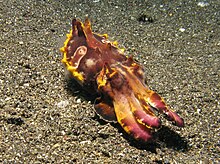| Metasepia | |
|---|---|
 | |
| Metasepia pfefferi | |
 | |
| Metasepia tullbergi | |
| Scientific classification | |
| Domain: | Eukaryota |
| Kingdom: | Animalia |
| Phylum: | Mollusca |
| Class: | Cephalopoda |
| Order: | Sepiida |
| Family: | Sepiidae |
| Genus: | Metasepia Hoyle, 1885 [1] |
| Type species | |
| Sepia (Metasepia) pfefferi Hoyle, 1885 | |
| Species | |
Metasepia is a small genus of small cuttlefish from the Pacific Ocean. The two members of this genus are characterised by a small, thick, diamond-shaped cuttlebone.